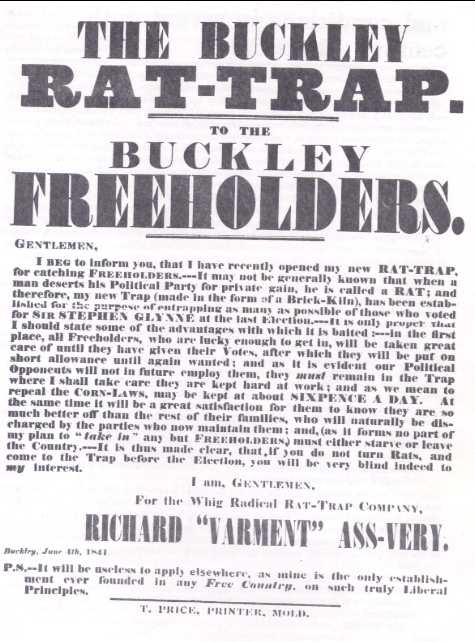
Buckley Society Magazine Issue Four: The Buckley 'Trap' by C.J. Williams: article and poster of 'The Buckley Rat Trap'"

Trap, Buckley
4 June 1841
Buckley Society Magazine Issue Four, April 1976
see 28.302 for contents etc
POSTER TEXT
The Buckley Rat-Trap
to the Buckley Freeholders
Gentlemen,
I beg to inform you, that I have recently opened my new RAT-TRAP, for catching Freeholders.... It may not be generally known that when a man deserts his Political Party for private gain, he is called a RAT; and therefore, my new Trap (made in the form of a Brick-Kiln), has been established for the purpose of entrapping as many as possible of those who voted for Sir Stephen Glynne at the last Election.... It is only proper that I should state some of the advantages with which it is baited: ...in the first place, all Freeholders, who are lucky enough to get in, will be taken great care of until they have given their Votes, after which they will be put on short allowance until agian wanted; and as it is evident that our Political Opponents will not in future employ them, they must remain in the Trap where I shall take care they are kept hard at work; and as we mean to repeal the Corn-Laws, may be kept at about SIXPENCE A DAY. At the same time it will be a great satisfaction for them to know they are so much better off than the rest of their families, who will naturally be discharged by the parties who now maintain them; and, (as it forms no part of my plan to "take in" any but Freeholders,) must either starve or leave the country. It is thus made clear, that, if you do not turn Rats, and come to the Trap before the Election, you will be very blind indeed to my interest.
I am, Gentlemen,
For the Whig Radical Rat-Trap Company
Richard "Varment" Ass-Very
Buckley June 4th 1841
p.s...It will be useless to apply elsewhere, as mine is the only establishment ever founded in any Free Country, on such truly Liberal Principles.
T.Price, Printer, Mold
**********************************
ARTICLE TEXT
THE BUCKLEY "TRAP"
The area of Buckley called the Trap is well-known locally; the name is often used jokingly - a man of little education is said to have 'gone to the Trap College'. Less well-known is the origin of the word. According to Thomas Cropper, writing in Buckley and District, the houses at the Trap were mostly built by the Mostyn family:
A good proportion of voters' political opinions were then at the
disposal of the highest bidder, and in this way the Trap houses were built and given in exchange for votes. It so got its nickname as a trap to catch votes.1
The truth of this theory is demonstrated by a poster among the Bryn Yorkin MSS. in the County Record 0ffice.2 It was issued by the supporters of Sir Stephen Glynne of Hawarden Castle, one of the candidates in the Flintshire Election of 1841.
The contest, between Sir Stephen and E.M.Lloyd Mostyn (later to become the second Lord Mostyn), was bitterly fought. Both candidates, as was then customary, put pressure on their tenants to vote the right way. The contest ended in July in a victory for Mostyn, the Whig candidate, but Sir Stephen petitioned against his election on the grounds that he had used corrupt practices; the petition was successful, and Glynne replaced Mostyn as the elected member in May 1842.
Sir Stephen's brother-in-law, W.E.Gladstone, helped him in his campaign, and spoke in his support. Both men were on occasion exposed to considerable physical dangers, for the Mostyn faction used mobs to break up their opponent's meetings. In his diary Gladstone described an election riot in Mold on 8 July 1841, when after the poll a mob of 150-200 men with heavy-headed sticks came down the street and remained in front of the Black Lion:
They stopped in front, capering in their manner, whirling their bludgeons over their heads, and striking them upon an empty omnibus like a drum, apparently by way of exercise rather than with a purpose of destroying it.At last one man of Glynne's began to flourish a stick and a fight arose... Not less than five or six with bludgeons belaboured him ferociously all aiming at the head - he was soon insensible and his escape with life was a great mercy. The house was besieged, doors and windows stove in, stairs barricaded for defence, no commander, few sticks, women crying, drunken men jabbering like geese for some two hours: the soldiery did not arrive until much later... 3
Mrs Gladstone, in a letter written the following day, described how her brothers escape:
- Henry Glynne (the rector of Hawarden) through a window, Sir Stephen down a ladder.4
The poster, issued for the 'Whig Radical Rat-Trap Company' by Richard Ass-Very (clearly a pun on the name of a Mostyn agent called Astbury) describes how a new Rat-Trap 'made in the form of a Brick-Kiln' had been recently established to trap those who had voted for Glynne at the last election. No doubt great pressures were put on tenants on this small piece of the Mostyn estate to make them vote for their master. In an area dominated by the Glynne family, this influence would be particularly noticeable, and resulted in the name Trap being preserved as a Buckley place-name.
1.T. Cropper, Buckley and District (1923), p.12
2.CR0 D/DM/294/3.
3.M. R. D. Foot and H. C. G. Matthew, The Gladstone Diaries, Vol. 3 (1974), pp. 123-4.
4.Glynne-Gladstone MSS., St Deiniol's Library, Hawarden: Catherine Gladstone to Lady Lyttelton, 9 July 1841. Lady Lyttleton, 8 July 1842
Author: Williams, Christopher J.
Tags
Year = 1841
Month = June
Day = 4
Document = Ephemera
Event = Other
Extra = Pre 1900
Copyright © 2015 The Buckley Society